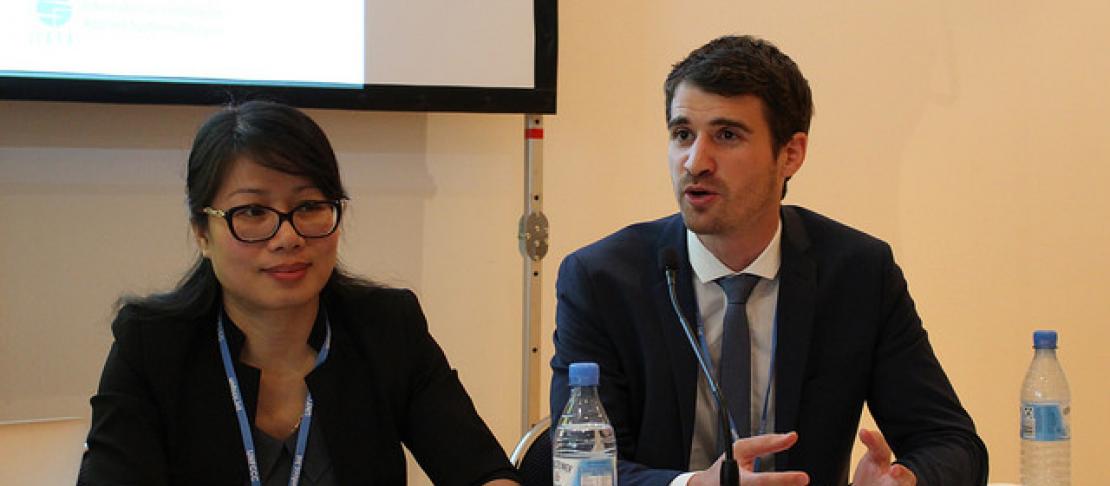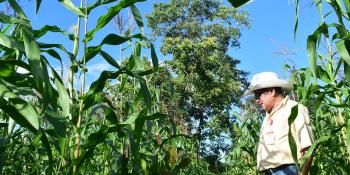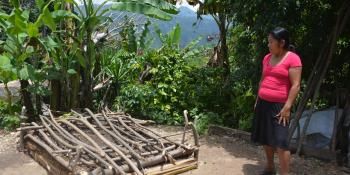Negotiators and scientists discuss country emissions targets for agriculture at SBSTA 44

Many countries include agricultural mitigation in their climate plans, but are the targets feasible, fair and ambitious-enough to curb climate change?
A new round of climate discussions is underway in Bonn. In the United Nations Framework Convention on Climate Change (UNFCCC) Subsidiary Bodies for Scientific and Technological Advice (SBSTA) 44 meeting, much of the buzz is around Nationally Determined Contributions (NDCs)—the pledges countries have made to reduce emissions under the Paris Agreement. While mitigation from agriculture is not formally part of the discussions at SBSTA, many countries included agricultural mitigation in their NDCs.
At a side event on 18 May, scientists from the CGIAR Research Program on Climate Change, Agriculture and Food Security (CCAFS), the International Institute for Applied Systems Analysis (IIASA), and the National Wildlife Federation joined delegates from Ethiopia, Viet Nam and Colombia to discuss targets for mitigation from agriculture: how countries can determine what is feasible, fair, and necessary to limit climate change.
Experiences from Ethiopia, Vietnam, and Colombia
Selamawit Desta, Environmental Law Expert at Ethiopia’s Ministry of Environment & Forestry and climate change negotiator, explained Ethiopia's experience:
Ethiopia’s targets for mitigation were based on our Climate Resilient Green Economy Strategy, so when it came time to formulate our Nationally Determined Contribution, the work was already done. Furthermore, each sector ministry has a climate change unit, so the work of each ministry is aligned with the Strategy.
To develop the Green Growth Strategy that was the basis for its NDC targets, Ethiopia identified 150 initiatives that had the potential to reduce emissions and prioritized 60 of the initiatives based on their local relevance, feasibility, contribution to economic growth, and potential for emission reduction at a reasonable cost. As an example, one prioritized initiative is to support professional farmer cooperatives, which can help spread innovations such as cross-bred cows that produce two to five times more milk than purebred indigenous cattle. Ethiopia expects that increasing the share of cross-bred cattle could dramatically increase marketable dairy yields with a lower cattle population– raising incomes while reducing livestock-related emissions by 45 million metric tonnes of carbon dioxide equivalents (MtCO2e) per year in 2030.
According to Le Hoang Anh, Senior Advisor for the Department of Science, Technology and Environment in Vietnam’s Ministry of Agriculture and Rural Development, Vietnam used a similar process to establish a target to reduce emissions from agriculture by 20% every 10 years, with an emphasis on reducing emissions from flooded rice production.
Meanwhile, Colombia has pledged to reduce 20% of its emissions across all sectors by 2030. Ivan Dario Valencia, Coordinator of the Colombia’s Low Emissions Development Strategy, explained,
Integrating agriculture, forestry, and other land use into our target was a challenge, because going into the process, our emissions baselines were missing land use emissions.
Working with CCAFS and the International Food Policy Research Center (IFPRI), Colombia used modeling tools to establish a baseline of emissions in the absence of mitigation and then explored different mitigation options and scenarios, such as the development of projects to integrate trees into livestock grazing systems. Read more about Colombia's INDC.
Do NDCs add up to enough mitigation to meet the Paris Agreement?
Mitigation initiatives in agriculture, such as those described by Colombia, Ethiopia and Vietnam, will be necessary in order to meet the goal of limiting global warming to 1.5 to 2 degrees Celsius in 2100, as established at the December climate talks in Paris. Scenarios for a 2-degree world show that methane and nitrous oxide emissions from agriculture must be reduced by 1 Gigatonne of CO2e emissions per year by 2030, compared to what would happen if we took no action at all. Only 21-40% of mitigation could be achieved with known practices, such as sustainable intensification of cattle, as planned in Ethiopia, and efficient use of water through alternate wetting and drying in irrigated rice, as planned in Vietnam.
The challenge is reducing emissions a further two to five times, without compromising food security. Stefan Frank and his colleagues at IIASA have modelled different pathways of mitigation for emissions from agriculture, forestry and other land use (AFOLU), implemented using a tax on emissions. Stefan summarized:
Low levels of mitigation are possible with little impact on food security, but higher levels of mitigation—like those needed for the two-degree target—could increase food prices and decrease food security.
Achieving the necessary mitigation with minimal impact on food security will require the participation of all countries and the full use of mitigation options such as soil carbon sequestration alongside new technologies such as methane inhibitors that reduce dairy cow emissions by 30% without affecting milk yields. Meeting that challenge will require smart policy design.
The private sector also has an important role to play in countries meeting their NDC commitments. Commodity agriculture is the largest driver of deforestation. In his presentation, David Burns of the National Wildlife Federation explainedhow voluntary efforts by agricultural companies—such as certifications, moratoria on purchase of agricultural products from deforested areas and individual company commitments—can make huge contributions to reducing the climate impacts of agriculture. He said:
Voluntary mechanisms limit deforestation at the producer level, so they can be a stepping stone to achieving jurisdictional and national reductions in deforestation.
Increasing ambition: beyond the farm
While the presenters and panelists focused primarily on supply-side mitigation—what happens on the farm—participants in the session brought up the important role that consumers play in reducing agricultural emissions, by reducing food waste and making food choices with the climate in mind. As one participant said:
Meat consumption and dietary change can be important measures in achieving these goals.”
Panelists agreed that more work was needed on the potential for consumption-side mitigation, and how it could relax potential trade-offs with food security.
Next step: implementation
While setting ambitious targets for mitigation is a first step, the next challenge is how to implement those targets.
Participants in the session wanted to know how incentives for mitigation can be provided to farmers, especially smallholders, who are “not talking about climate change, let alone mitigation.” Panelists emphasized that the primary driver for farmers to change practices in developing countries will be agricultural development and adaptation to climate change, but that such development can have substantial mitigation co-benefits.
Well-designed policy combined with initiatives to get new knowledge into the hands of farmers can allow countries to take full advantage of those benefits.
All presentations are available by clicking on the title in the program below.
Program
Welcome. Moderator: Ana Maria Loboguerrero Rodriguez (CCAFS, CIAT)
Part 1. Setting country mitigation targets for agriculture
- Mitigation from agriculture in the INDCs: What are fair targets? Meryl Richards, CCAFS and the University of Vermont
- Extent of regional/country participation needed in mitigation to meet climate targets and the possibility of enabling exceptions for food insecure countries, Stefan Frank, International Institute for Applied Systems Analysis (IIASA)
- Lessons from agricultural commodity supply chain interventions and REDD+, David Burns, National Wildlife Federation
- Discussion and clarification questions
Part 2. Calculating country mitigation targets in agriculture. Moderated chat show with:
- Ms. Selamawit Desta, Environmental Law Expert and Climate Change Negotiator, Ministry of Environment, Forestry and Climate Change, Federal Democratic Republic of Ethiopia
- Ms. Le Hoang Anh, Senior Advisor, Department of Science, Technology and Environment, Socialist Republic of Vietnam
- Mr. Ivan Dario Valencia, Coordinator, Colombian Low Emissions Development Strategy
Part 3. Discussion: Where global and country targets meet
Final remarks: Finding the common ground of fair, ambitious and feasible, and resources, Ana Maria Loboguerrero Rodriguez (CCAFS, CIAT)
The side event was organized by CCAFS in partnership with the International Center for Tropical Agriculture (CIAT), the International Food Policy Research Institute (IFPRI), the International Institute for Applied Systems Analysis (IIASA) and the National Wildlife Federation (NWF).
Poster presentation at SBSTA 44 research dialogue
Stefan and Meryl also presented this poster regarding targets at the SBSTA research dialogue on May 19, 2016.
Further readings:
- Research highlight: Majority of climate change pledges to the UN include climate change adaptation and mitigation in agriculture
- Research highlight: Annual emissions reductions from agriculture must reach 1 GtCO2e per year by 2030 to stay within 2°C warming limit
- Journal article: Reducing emissions from agriculture to meet the 2°C target
- Poster presented at SBSTA: Reducing emissions from agriculture to meet the Paris Agreement goals
Meryl Richards is conducting research on countries' targets and NDCs to the UNFCCC process with support from the United States Agency for International Development (USAID). See data and analysis of INDCs here.
Julianna White, program manager, edited and uploaded this blog.
Read all coverage from SBSTA on our blog.


